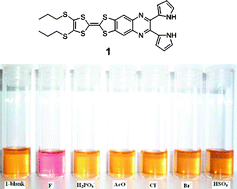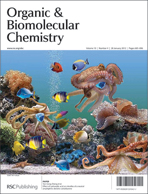Fluoride-selective optical sensor based on the dipyrrolyl-tetrathiafulvalene chromophore†
Abstract
A chemosensor bearing dipyrrolyl motifs as recognition sites and a tetrathiafulvalene redox tag has been evaluated as an optical and redox sensor for a series of anions (F−, Cl−, Br−, HSO4−, CH3COO−, and H2PO4−) in DCM solution. The receptor shows specific optical signaling for fluoride but little electrochemical effect in solution. The solid-state performance of the sensor leads to measurable changes in


 Please wait while we load your content...
Please wait while we load your content...